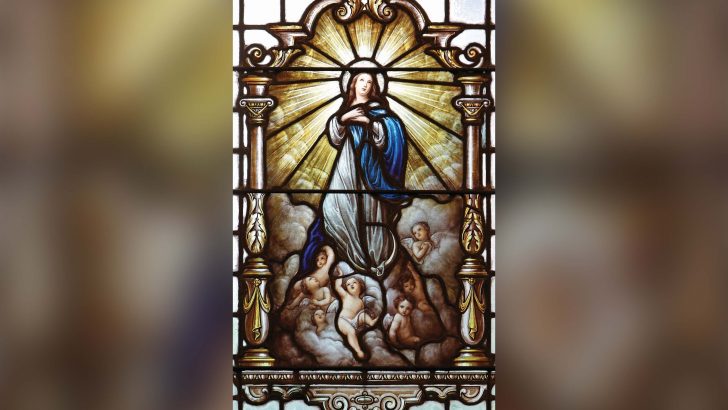The Church leaves the question of whether Our Lady actually died open, writes Daniel Holmes
In recent days a Catholic journalist whom I greatly respect, in referring to Our Lady’s Assumption into heaven, used the phrase “After her death”. For the first time, that phrase urged me to become more conscious of what the Church actually teaches about Our Lady’s human nature and to seek out some of the many references to the Virgin Mary’s death and assumption into heaven – references found in the works of such incomparable authorities as St Augustine, St Thomas Aquinas and St Alphonsus Liguori. Such authorities as these instil massive hesitations in the limited understanding of those who might wish to comment or conjecture on whether or not Our Lady actually experienced death in any possible form; these hesitations are particularly troublesome when ones such as Aquinas and Alphonsus clearly assert that she did die before her soul and uncorrupted body were reunited and assumed.
Body and soul
I do not for a second doubt what the Church teaches about Mary’s body and soul assumption into heaven, but presently I am now more aware of the existence of two schools of thought – one of which accepts the proposed fact of Mary’s death and the other which asserts that Mary did not die and, in fact, could not die because she was immaculately conceived, redeemed and preserved from the inherited deadly contagion of original sin and lived an earthly life “full of grace” and untouched by any shadow or stain of actual sin. In explaining Adam’s original transgression in Eden, St Paul says that “sin came into the world through one man and death through sin” (Romans 5:12). With reference to that ‘sin’ Pope St Pius IX infallibly proclaimed in Ineffabilis Deus (1854) the dogma of the Immaculate Conception: “The Most Blessed Virgin Mary was from the first moment of her conception…preserved immune from all stain of original sin”. Consequently one might, as others have, reasonably and theologically concluded she was also ‘preserved immune’ from death.
In Munificentissimus Deus (1950) Pope Pius XII dogmatically and infallibly states that “the Virgin Mary, having completed the course of her earthly life, was assumed body and soul into heavenly glory.” Moreover, the Catechism of the Catholic Church consciously using similar language and imagery, states that “the Immaculate Virgin, preserved free from all stain of original sin, when the course of her earthly life was finished, was taken up body and soul into heavenly glory”.
It is noteworthy that neither the 1950 declaration nor the catechism explicitly proclaim Mary’s death as an established and verifiable fact; and of course there have been for centuries past much theological attention given to this fascinating issue which has been addressed by so many, We might reasonably say that in 1950, in modern times, this question was closely and very visibly scrutinised again. Following on from Pope Pius XII’s declaration we still find continuing forthright assessment and comment on the perennial question as to whether or not Our Lady was confronted with death. For example, in Sheehan’s 2001 edition of Apologetics and Catholic Doctrine we find the following: “The Pope deliberately left open the question of whether or not Our Lady died before her Assumption”.
Earthly life
This conclusion has been widely acknowledged to emphasise clearly that Our Lady was assumed body and soul into heaven when she had “completed the course of her earthly life” but it does not at all suggest that she died before her assumption occurred. Nevertheless, although the question has been left open, it also has to be acknowledged that there is among the Faithful almost a universally presumed and accepted belief that she did briefly pass through death in some form before her soul and uncorrupted body were reunited and assumed into God’s immediate presence.
In contrast to this general understanding of the Assumption there is another school of thought with perhaps fewer advocates who legitimately assert on a sound, logical theological and orthodox basis that the Virgin Mary, being immaculately conceived, could not possibly be vulnerable to the inherited contamination of the original sin which inflicted death on all of humankind. They also maintain that not only was Mary luminously sinless and thus preserved from death but she was preserved also from the physical forces and effects of ageing which dictate the gradual degeneration of the body until body and soul are separated and death inevitably occurs.
In the light of the above considerations, and with the question of Mary’s death consciously left open, it is therefore acceptably orthodox to say that Catholics are not bound to believe in her mortality as a matter of dogma. It might well be accurate to surmise and conjecture, as some do, that when Our Lady grew into the resplendent prime of her young womanhood her incorruptible physical appearance remained in its primal beauty despite the passage of years; the mortal effects of ageing were rendered powerless whilst she waited to complete “the course of her earthly life” when her God would summon her and assume her into his divine presence and her eternal home. Finally, some again might find it interesting and certainly particularly relevant to recall here that in the Fourth Century Timothy of Jerusalem described the Virgin Mary as ‘immortal’. Needless to say, it’s only recently that I have been perhaps a little more able to better understand what he meant.
Daniel Holmes is a reader of The Irish Catholic from Co. Derry.


 The Assumption of Mary is depicted in a stained-glass window at St Mary’s Church in Manhasset New York. Photo: CNS.
The Assumption of Mary is depicted in a stained-glass window at St Mary’s Church in Manhasset New York. Photo: CNS.